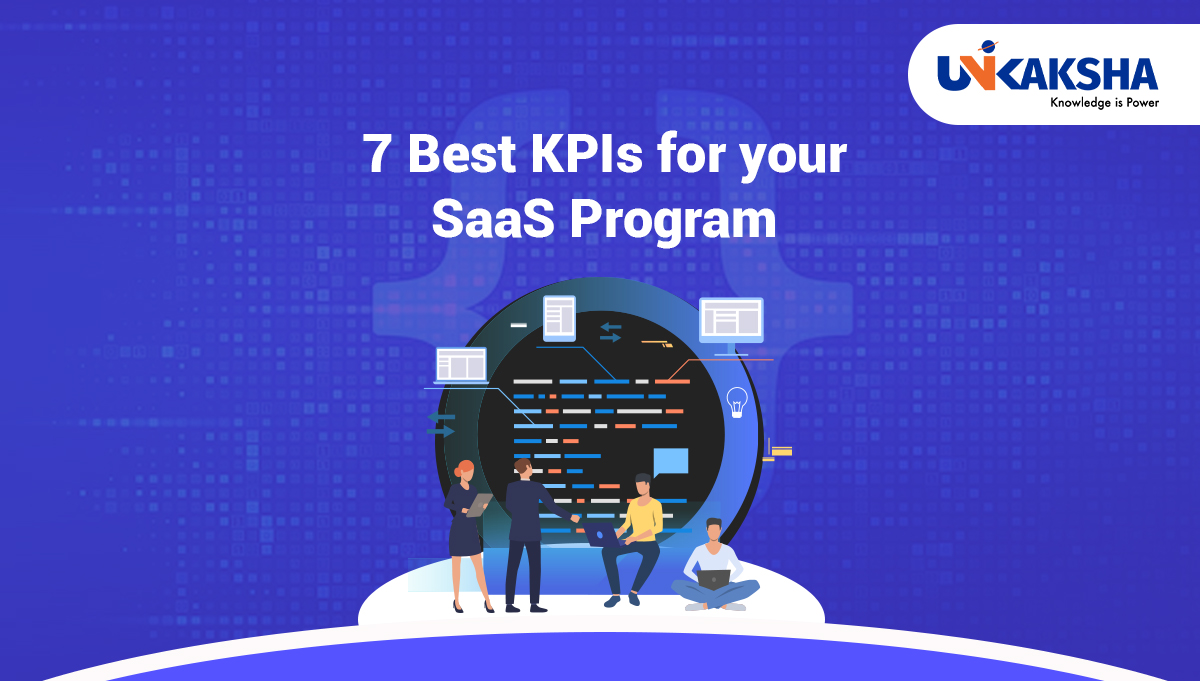7 Best KPIs for your SaaS Program

Technological innovations have completely shifted how people run their businesses and diverse operations. One of the most powerful innovations that have rocked the world of business activities in recent times is the SaaS or software as a Service. Implementing the best KPIs for SaaS is crucial for optimizing your program’s performance and driving sustainable growth.
According to a survey by thrivemyway, the SaaS market has tripled its size in the last five years and is growing 6.5x faster than the rest of the global economy.
It is a way of carrying out software delivery through which the end users can access the data online using any connected device. Instead of having the software installed manually on the system, it makes it possible for people to access the software through the internet so that the hassles of physical installation and maintenance can be avoided. The pandemic has made it important for people to work from home and as a result, it has become important for more companies to make use of SaaS products.
Even though this has naturally paved the way for great expansion for companies involved in the research and development of SaaS programs, it has made it necessary for business houses to come up with methods through which they can measure their performance. While working with a SaaS program, a leading SaaS company can have in place metrics to measure their performance and come up with strategies that can help them to improve their functioning. This is something that they can easily achieve with the help of KPIs.
What are KPIs?
A KPI or a Key Performance Indicator functions as a type of quantifiable measurement that is used for assessing the performance and progress towards a definite goal or target in a company. When businesses need to operate within a fast-changing digital landscape, they have to deal with new sets of data all the time. This means that companies always face a challenge when deciding which KPIs would be the most suitable for them. A company must make use of the most relevant KPIs as using too many or too few of them is going to bring in a lot of obstacles when it comes to making data-driven decisions.
Register today for 4 months TechFit – Full Stack Web Development Program and become job-ready even before you graduate.
Here are 7 best KPIs for SaaS program:
Here is a look at some of the most important KPIs for a SaaS Program.
1) Customer Churn Rate
Customer churn rate is a SaaS KPI that defines the percentage of customers signing up for a SaaS service and then canceling the subscription in a certain time frame. Since most SaaS products are subscription-based, SaaS companies must focus on retaining the existing customers and getting new ones. There are always going to be some people leaving the subscription once they have signed up. The customer churn rate KPI helps to keep track of that figure.
*Churn Rate Formula
Lost Customers / Total Customers at the start of the period x 100
For example, if you started with 100 clients and ended with 70 after three months, you are required to divide 70 by 100 to get 0.7 – your churn rate. Then, you must multiply the result by 100 to turn it into a percentage. In this case, you have a 70% churn rate.
2) Monthly recurring revenue (MRR)
Monthly recurring revenue or MRR is considered to be the main driving aspect behind SaaS-based companies. The MRR metric helps to measure the total amount of money that the customers have invested in the products offered by the SaaS company every month. Therefore it can be said that MRR is a vital metric for correctly predicting the prospects of the SaaS business. It can also assist with better financial planning and financial forecasting. The three main aspects of MRR are New MRR, expansion MRR and churn MRR.
Monthly Recurring Revenue (MRR) Formula
The number of monthly subscribers x Average Revenue per User (ARPU)
For example, if you have 10 subscribers on your monthly plan of Rs500, your MRR will be:
5 x Rs500 = Rs 2500
If the SaaS business is based on annual subscriptions, then you are requested to divide the annual plan price by 12. Then, multiply the result by annual plan subscribers.
3) Revenue Churn
Revenue churn can be defined as the amount of money or revenue lost because of the customer churn. It also takes into account the varying pricing options that a company has. Even though the revenue churn may seem to be similar to customer churn, there are some key differences between the two. It is because some customers can bring more revenue compared to others based on the subscription type that they have or users or licenses that a customer has. This means that just because a company’s customer churn rate stays low, it doesn’t mean that the revenue churn is also going to be low.
*Monthly Revenue Churn Formula
(MRR beginning of the month – MRR end of the month) * MRR in Upgrades during month / MRR beginning of the month.
4) Customer lifetime value (CLV)
Customer lifetime value is an important SaaS KPI metric that allows you to determine the amount of total revenue that can be generated by a specific custom throughout the duration of time when he or she has got the subscription. It is important to track the customer lifetime value or CLV because it can help in determining the market value and the success rate of a particular SaaS product. As most of these operate in subscription-based models, getting the subscriptions renewed can be a great way of boosting the CLV for a customer.
*Customer Lifetime Value (CLV) Formula
To calculate Customer Lifetime Value, calculate the average purchase value and multiply the result by the average purchase frequency rate. This will measure the customer value. Then, you are required to calculate the average customer lifespan and multiply it by the customer value.
Customer Lifetime Value (CLV) = (Average Purchase Value * Average Purchase Frequency Rate) * Average Customer Lifespan
5) Customer Acquisition Cost (CAC)
Customer acquisition cost or CAC can be defined as the measurement of resources needed to get one new customer. When a company understands the level of investment that it needs to make to get a new customer, it can become easier for the business to determine the best sales and marketing methods for ensuring success for the SaaS business.
*Customer acquisition cost (CAC) Formula
Total Sales & Marketing Costs / Number of New Customers = CAC
6) Lead Velocity Rate (LVR)
Lead velocity rate or LVR helps to compare the total count of qualified leads that are generated in 2 specific and different periods. When represented as a percentage, LVR functions as a metric that indicates the efficiency of a sales pipeline. It can also illustrate the growth potential of a SaaS business in the long term.
*Lead Velocity Rate (LVR) Formula
(Number of Qualified Leads Current Month – Number of Qualified Leads Last Month) / Number of Qualified Leads Last Month * 100 = LVR
7) Net Promoter Score (NPS)
Net promoter score functions as a quantitative and qualitative way to measure effectively and directly the value customers associate with a particular SaaS product and the level of satisfaction they have while using it. Hence it plays a crucial role in defining the success of a SaaS business.
*Net Promoter Score (NPS) Formula:
To calculate your Net Promoter Score, subtract the percentage of the detractors from the percentage of the promoters.
Wrap-Up
In the end, understanding, calculating, and improving the KPIs can mean getting a clear hawk’s eye view of your SaaS business processes. Successful entrepreneurs know that the growth and profitability of a SaaS company are highly dependent on data-driven decisions. To make those decisions work, it is not enough just to understand your KPIs, you should be smart enough to comprehend how to monitor and track them.
About the Author
Sonali is an accomplished Author, Content Writer, Copywriter, and Ghostwriter, known for her ability to create engaging and captivating communications. With over 11 years of experience, she has developed a diverse industry background in Education, Travel, Retail, Events, and Fashion . Quality over quantity is what she firmly believes in. At UniKakhsa, she leads a team of talented technical writers, dedicated to delivering valuable content to readers through our blogs.
 Related Posts
Related Posts
|
Offerings
|
FutureFirst
|
SmartStart
|
GradEdge
|
SelfMastery
|
|---|---|---|---|---|
|
Doubt clearing session
|
                                          |
                                          |
                                          |
                                          |
|
No of job opportunities
|
15 | 25 | 15 | 3 |
|
Course Access
|
5 Years | Lifetime | Lifetime | 5 Years |
|
Free Library Courses
|
                                          |
                                          |
                                          |
                                          |
|
Job Assurance
|
                                          |
                                          |
                                          |
                                          |
|
Language
|
English/Hindi | 5 Language options | English/Hindi | English/Hindi |
|
Live classes
|
100% | 100% | 100% |                     |
|
Offline
|
                                          |
                                          |
                                          |
                    |
|
Industry Expert Sessions
|
                    |
                                          |
                    |
                    |
|
Internship (IOP)
|
                                          |
Guaranteed | Guaranteed | Based on evaluation |
|
1:1 Mentoring sessions
|
                    |
                                          |
                    |
                    |
|
Customer Support
|
                                          |
                                          |
                                          |
                                          |
|
Dedicated Program Manager
|
                    |
                                          |
                    |
                    |
|
Opt for Placement services
|
Compulsary |                                           |
                                          |
                                          |
|
Career Support
|
1 Year | 18 Months | 1 Year | 3 Months |
|
Regular assessments
|
                                          |
                                          |
                                          |
                                          |
|
Report cards
|
                                          |
                                          |
                                          |
                    |
|
Career Guidance
|
                                          |
                                          |
                                          |
                    |
|
Certificates
|
                                          |
                                          |
                                          |
                    |
|
Scholarship
|
                                          |
Available | Available |                     |
|
Trial Class
|
1 week | 1 week | 1 week |                     |
|
Outside placement
|
Paid | Allowed | Allowed | Allowed |
|
Premium Jobs
|
                    |
                                          |
                    |
                    |
